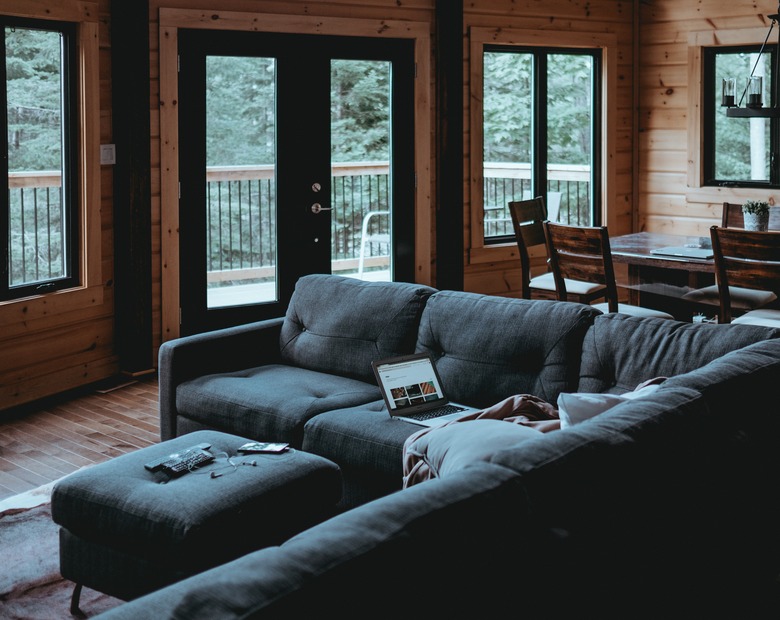How To Make Paneling Look Like Sheet Rock
The wood or hardboard paneling in your living room or den may have been a good idea when it was installed, but now, perhaps the time has come for a change. No, you don't have to take it down to make the change — and giving it a new face may be easier than you think. Using a mudding technique called skim-coating, you can give the paneling a smooth finish without removing a single panel or hanging a single sheet of drywall. All you need is some primer, a few hand tools, some drywall joint compound and a couple days of your time.
An Overview of the Process
An Overview of the Process
Skim-coating involves spreading several layers of drywall joint compound directly over the paneling, scraping it flat and sanding it to a smooth finish. To prepare the paneling for this treatment, you have to clean it thoroughly and then apply a coat of stain-blocking primer, which helps the joint compound to adhere. An important part of the process is to secure lifting seams with nails and, if necessary, tape them. After the final sanding, you apply a coat PVA drywall primer to the entire wall, and it's ready for paint or wallpaper.
Cleaning
Cleaning
Whether or not your old paneling has a finish, it has had plenty of time to absorb grease and oils from the air, and even small amounts of such contaminants can prevent primer and mud from adhering. To remove dirt, grease and oils, mix a solution consisting of 1/2 cup of trisodium phosphate (TSP) in a gallon of warm water. Wear gloves and goggles as you scrub the walls with a sponge or rag, because TSP is mildly caustic and can cause irritation. Let the paneling dry completely before proceeding.
Priming and Prepping
Priming and Prepping
Before priming, remove all the baseboards and other decorative trim using a pry bar and hammer.
If your paneling is finished, you need a primer that will adhere to the finish and to which the mud will adhere. If the paneling is unfinished, the primer should provide enough of a seal to prevent knots and sap from bleeding through the mud. A good interior, water-based, stain blocking primer does both. Apply it with a brush, and be sure to get complete coverage in all the grooves.
Once the primer has dried, it's time to nail down all the loose seams with ring-shank nails. In most cases, that's all you need to do, but if the seams are wide or unstable, tape them with joint compound and fiberglass drywall tape.
Skim-Coating Procedure
Skim-Coating Procedure
Skim-coating involves the application of three or more coats of joint compound. The first coat is a seal coat, and for this, it's best to use sandable setting-type joint compound. This type of joint compound, also known as hot mud, resists cracking and peeling better than the all-purpose variety. Use all-purpose joint compound for all the other coats except the last, for which it's best to use topping compound, a lightweight and highly spreadable type of mud that creates a smooth finish.
1. Apply the First Coat
Spread hot mud into all the seams, knots and depressions to fill them, and scrape the mud flat with your 4- or 6-inch drywall knife. Be meticulous about scraping because, while hot mud is sandable, it isn't as easy to sand as the all-purpose variety. Let the mud set — which should take an hour or two — then sand with 120-grit sandpaper.
2. Apply the Mid-Coats
Spread all-purpose joint compound over the entire wall with a 10-inch drywall blade, being sure to fill any depressions still there, as well as the grain of the paneling. Don't try to smooth the wall on the first coat — several thin coats dry more evenly than a single thick one, and they won't crack. Sand the first coat when it dries, then apply another. Apply a third coat of if you want a smoother finish.
3. Apply the Last Coat
Sand the previous coat with 120-grit paper, then mix a batch of topping compound and apply it to the entire wall. Scrape with a 10-inch drywall knife. Let the topping compound dry, and then sand it with 150-grit sandpaper.
4. Prime the Wall
Wipe the wall down with a soft rag to remove all the sanding dust, then spread a single coat of PVA drywall primer over it. The primer will seal the porous surface and provide a substrate for paint or wallpaper.
Skim Coating Is an Art
Skim Coating Is an Art
Although the procedure is simple enough, it can be difficult to achieve perfection when skim-coating, especially on your first try. The following tips will help you get the best results:
- Mix mud to the consistency of honey and keep it in a drywall trough with a metal scraping edge. Keep your drywall blade clean by scraping it often on your mud trough.
- Pick all small pieces of paper or dried mud out of your trough before scooping mud onto your blade. Small debris leaves tracks on the wall when you scrape.
- Shine a work light on the wall from several angles when doing the final sanding. The light will help you spot small ridges and defects that you might not see initially but which will show up after painting.
